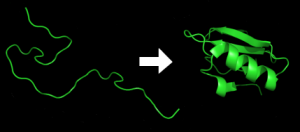How life first originated on Earth is always an interesting subject. A structural biologist and his team of researchers at Florida State University College of Medicine have identified 10 amino acids that existed on our planet for 4 billion years. These amino acids exhibit foldable behavior capable of metabolic activity and are the precursors to life emerging on the planet between 3.9 and 3.5 billion years ago. The environment of Earth at the time was high in salt stated Dr. Michael Blaber who heads up the team that has proposed this new theory on how the first living organisms came into existence.
How does this differ from other explanations of the origins of life? Most theories point to RNA as the precursor to the evolution of living things. Professor Blaber believes that proteins came first made from amino acids that interacted with the extreme salt and heat conditions on early Earth. The Earth of 4 billion years ago was largely salty oceans and volcanic land masses with the hot and almost boiling atmosphere largely comprised of CO2 and nitrogen. Blaber states, “for life to exist in such environments it is essential that proteins are able to adapt in those conditions. In other words, they have to be able to fold.”
The diagram below illustrates how a linear chain of amino acids folds into a three-dimensional shape to form a protein. In biological entities folding is governed by helper proteins. But in the early environment of Earth a few amino acids spontaneously folded in the high salt conditions prevalent on the planet.
Comets and asteroids more than likely brought early amino acids to Earth. We know this because when we study the chemistry of space we find evidence of amino acids in the night sky. And we also find this evidence in meteorites that strike the Earth from time to time. So amino acids are common to the chemistry of our Universe. And of the 20 amino acids commonly found in our bodies, 10 predate Earth and all living things. We call these amino acids prebiotic, meaning before life. These 10 can be made through chemical interactions not requiring biology.
How did Blaber and his team derive their hypothesis and draw their conclusions? They used top-down symmetric deconstruction, a methodology to identify the building blocks of proteins. They were able, therefore, to identify 12 precursor amino acids. According to Blaber that get them 80% of the way to proving their theory of 10 amino acids being responsible for abiogenesis, the spontaneous assembly of proteins leading to biosynthesis and life.
Blaber and his associates published their findings recently in the February issue of the Proceedings of the National Academy of Sciences of the United States of America.
To get a better understanding of the role of amino acids and foldable proteins view this YouTube posted video. What you are watching represents the building blocks that have led to us, at least according to Blaber. Some who cast doubt on this hypothesis point out that in most living cells salt is excluded from the internal environment. But as we find more extremophiles, we are beginning to find evidence that some living things tolerate being immersed in environments in which salt permeates living cells.









